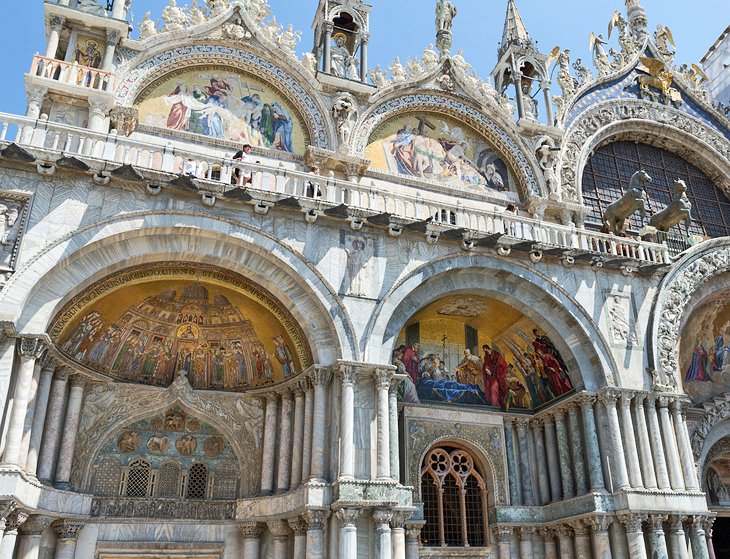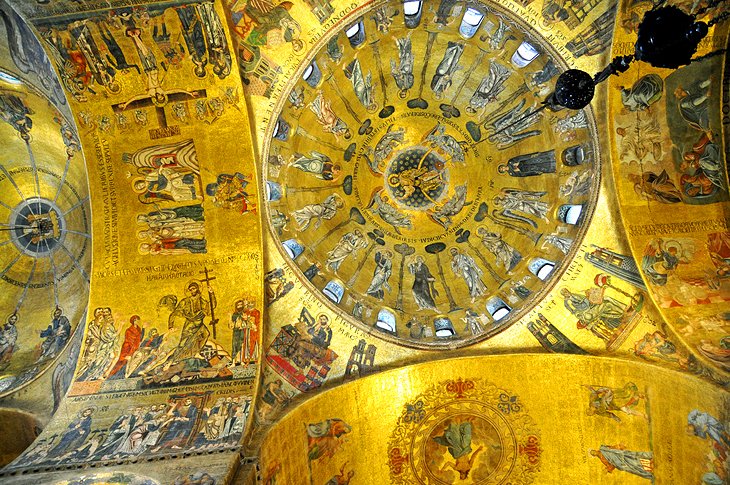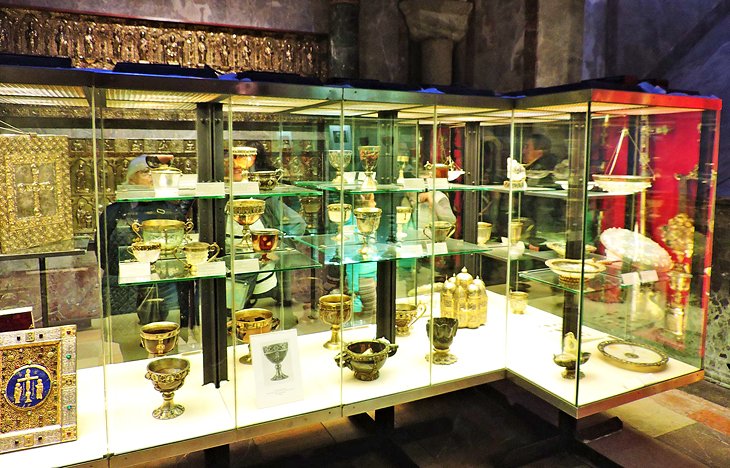The Translation of the Relics of Saint Mark, the Evangelist – 31 December
The story of how Saint Mark’s relics eventually came to Venice is a remarkable one and it has been the subject of various works of art throughout the centuries. Tintoretto’s
Translation of the Body of Saint Mark, a stark, dramatic painting that has the eerie feel of a photo negative, may be one of the most recognisable. Painted between 1562 and 1566 for the Scuola Grande di San Marco, the work is part of the permanent collection of the Accademia Galleries in Venice. Tintoretto himself is portrayed within the work, as the bearded man beside the camel.
A companion painting, Discovery of the Body of Saint Mark, is located at the Brera Gallery in Milan.

The glittering mosaics that adorn the exterior of Saint Mark’s Basilica also tell the story, in tessellated form, of the translation of Saint Mark’s relics. For example, the mosaic located above the left doorway (the Door of Saint Alypius) of the west facade depicts Saint Mark’s body being carried into the basilica. The mosaic, known as the Deposition mosaic, is the oldest exterior mosaic on the Basilica and dates to 1260-1270.


According to legend, Saint Mark’s body was taken from Alexandria, Egypt, in 828. Two Venetian merchants travelling in Alexandria, obtained the relics of Saint Mark from Priests at the church of Saint Mark, where the saint’s body was interred. The Priests feared Saint Mark’s relics might be damaged or destroyed by the Saracens during the persecution of the Catholic community in Alexandria. Promising to safeguard the Saint’s relics, the merchants convinced the Priests to allow them to return to Venice with the body of Saint Mark.
“The body of Saint Mark was taken out of the sarcophagus and unwrapped from its silk shroud, the relic being substituted by another and less eminent Saint. It was then placed in a chest and taken on board the Venetian ship, the merchants first ensuring, that the Saint’s remains were covered by a layer of pork and cabbage. When the Muslim officials asked to inspect the chest, they cried out ‘Kanzir, kanzir’ (Oh horror) at the sight and smell of the pork. . . . Thus the Evangelist was safely conveyed to Venice but not before a number of miracles eased his passage across the Mediterranean.”
Saint Mark’s body was initially kept in a Chapel at the Doge’s palace, a Chapel originally dedicated to Saint Theodore, until a more suitable Church could be built. Begun in 829, the year after the translation of Saint Mark’s relics, the first Church of Saint Mark was completed in 832. This Church was destroyed in 976 during a rebellion against Doge Pietro Candiano IV. And so St Mark’s Basilica was built to house the remains. Unfortunately, two hundred years later, the unthinkable happened, the authorities forgot where they had put them. Various excuses have emerged, all rather contradictory; there had been a fire, there was building work at the Basilica, the people who knew the location died suddenly without passing on the secret. All of Venice despaired but St Mark himself came to the rescue – his arm suddenly appeared from a pillar, no doubt accompanied by a shout of ‘I’m over here!’ The Basilica was completed in 1063 but was only Consecrated in 1094 now that St Mark was found.
In 1835, Giacomo Monico, Patriarch of Venice, exhumed the body of Saint Mark from the Crypt beneath the Basilica and placed it in the high Altar. Before then, the Saint’s body had apparently last been seen in the 12th century, dressed in ecclesiastical robes, when it was placed on display for five months for public veneration.
In 1075, the Doge passed a law requiring all returning ships to bring back something precious to decorate the Basilica, accounting for the more than 500 columns of rare marble, porphyry, alabaster and jasper brought back from the East. The interior is clad with 4,240 square meters of gold mosaics, mostly from the 12th and 13th centuries.
Between 1500 and 1750, some of the old sections were replaced by “modern” mosaics designed by artists including Titian and Tintoretto. The presence of St Mark, the mosaics, golden altar, beautiful chapels and treasury make St Mark’s one of Italy’s best-loved Churches.
Saint Mark’s simple, marble Sarcophagus can only be viewed from behind the high Altar. The exterior of the Sarcophagus is well lit and a short inscription applied to the stone in metallic letters read: “SALUTAT VOS . . . MARCUS FILIUS MEUS.” This inscription was followed by a citation in much smaller letters below the word “MEUS.” The citation read “1 Petri 5.13,” the source of the abbreviated quote on the tomb. The front of the Sarcophagus proclaims “CORPUS DIVI MARCI EVANGELISTAE” (Body of the Divine Mark, Evangelist). Red roses are often placed on top of the Sarcophagus.
In case you missed the video:












5 thoughts on “The Translation of the Relics of Saint Mark, the Evangelist – 31 December”